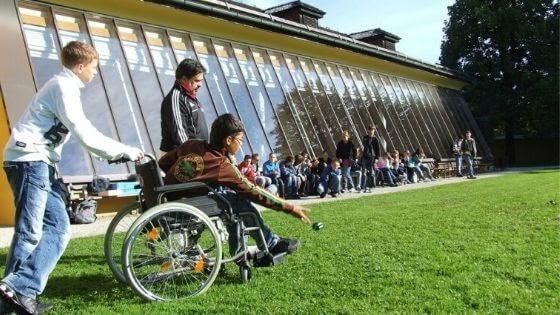The Best Equipment To Help SEND Students With Independent Learning
)
In the world, we come across many disabilities or limiting factors that can affect someone’s life. However, we often see how emerging technology and equipment has helped people take control of their own lives too, but how can we apply this to someone’s learning? There are so many opportunities for assistive technology to be used in schools, and we are often seeing them being implemented alongside learning support assistants. The main question is, since schools are struggling with budgetary restrictions, could it be more beneficial to provide students with equipment that allows them to become autonomous and take control of their own learning?

Where Schools Are Now
It has become relatively known that schools struggle with budget constraints as they need to perform within their own means. Unfortunately, this means schools can begin to struggle with their care for students with Special Educational Needs and Disabilities (SEND). For example, visually impaired students have recently been suffering from cuts due to a shortage of funds, which has led to thousands of Visually Impaired (VI) students being failed by the educational system. In fact, 44% of councils in England have either frozen or cut funding to support for VI students. What this means is that a large section of children in the UK are currently being failed, suffering a greater disadvantage at such a crucial stage in their lives.
Even more so, it is stated that funding for the current SEND population in UK schools is not enough to support their education, meaning that SEND students are at the frontline of budget cuts. The funding for the most vulnerable children and young people will still be £1.5 billion short. This current funding issue is clearly one of the many problems that come with educational cuts in the country, as SEND students have been failed across the nation due to the distribution of budgets.
This is a situation that has not been helped by the UK’s current political climate, but the Prime Minister has now pledged that there will be £14 billion increase in educational funding, meaning that SEND students would now gain a greater funding to improve their experience at school and help to guide their learning through targeted technology and equipment. This is exactly what is needed to assist the learning and development of SEND children, but is there a way that we can find a solution for the budget? In many cases, students with special educational needs are more than capable of performing in class but need assistive technology to become independent. This would mean that learning support assistants could be used only for more extreme cases of children with more severe needs.
How Can We Promote Autonomous Learning?
One of the greatest constraints to the budgets in schools revolve around the Learning Support Assistants (LSA’s). It costs a lot of money to allocate SEND students their own qualified, trained LSA that can help with their specific condition. While not impossible to accomplish, it can be very difficult to pay for. More often than not, we are seeing LSA’s run off their feet as they attempt to manage multiple SEND students throughout the day. So how can we take some pressure off them, while allowing SEND students with less severe requirements to control their own learning? We can provide them with the technology that they need to participate and engage in the class independently. Not only does this allow more free time for LSA’s, but also provides the students with the independence and confidence they need to develop their own learning.
In the same way that we looked at visually impaired students being directly affected by budget cuts, we can also look at specific solutions that can help them take control of their learning. For example, some VI students are very capable of engaging in the classroom but face barriers when it comes to individual, personal learning. These students can benefit from using BookShare, a digital learning assistant that helps them read at their own pace under conditions specific to their needs. This technology can assist a variety of degrees of visual impairment as it includes braille, audio, varying font size and more. This negates the need for an LSA to be present to assist and read with them, meaning that they are free to help a child with different needs. This is an amazing step, but there is other equipment that is readily available to help a wide range of disabilities.
The aim should be not only for SEND children to take control of their own learning, but to take control of their own lives. By improving access, integration and communication, we are helping these children become autonomous and providing them with the positive reinforcement that their disability is a part of them, but it is not what defines them. Providing assistive equipment and technology is an amazing way to give these children the equity they deserve in such a crucial developmental stage of their lives.
Assistive Equipment And Technology
There are so many different types of equipment and technology that can help the learning and general experience of school for SEND students. These not only work in the classroom but will assist children with carrying out homework or improve their day-to-day lives, by making things more accessible or manageable.
The Weighted Blanket - These can be fantastic for children with autism. There are many aspects of a school that can be distressing for children with autism, such as new students, different seating arrangements or any other changes to the environment. For this reason, it is important to try and help them become as relaxed as possible in the classroom. The weighted blanket is a fantastic way of helping this as it provides the sensation of a calming hug for the student without invading their personal space, which can make them feel even more anxious. Outside of school, it is also a brilliant way to help children with autism to get to sleep for the exact same reason!
Augmentative And Alternative Communication Technology (AAC) - This technology is designed specifically for children with speech difficulties to assist them in engaging in their learning. It typically consists of a screen or panel of buttons with images or symbols to help people communicate effectively. Higher quality versions can even produce audio communication, helping to make conversations more seamless.
Fidget Aids For ADHD - Students with ADHD can be amazing contributors to your classroom, provided that you know how to work well with them and make sure that they do not become too disruptive. As these students find it difficult to focus on tasks, you’ll find that they’ll begin finding reasons to leave their seat and move around. That is why you want to provide them with aids that will help them channel their energy. For example, the tangle toy is silent, so it doesn’t disrupt other students, but will keep students with ADHD busy while they are thinking. Alternatively, you may have come across fidget spinners, which occupy students, but can be a bit more overt and distract others in the classroom.
Ergonomic And Concept Keyboards - You will find that students may have physical impairments that limit their movement. For this, you can use ergonomic keyboards, which are a different design to help reduce the amount of muscle strain when in use. Additionally, using concept keyboards is an interesting way to help children communicate, type, carry out work and more, as they will be able to map and have their own custom buttons, meaning that they can be customised for different specific needs.
Pointing Devices And Joysticks - These are an alternative for students who may not be able to physically use a mouse or keyboard. This would mean that they can point at a virtual keyboard to type, which would effectively work the same as a standard keyboard. Additionally, there are options for head-mounted versions for those who are not physically able to point the device with their hands. Another use for students with limited movement is the joystick. It can be far easier to control for a SEND child to use, both in class and at home.
Palantype Or Radio Aids - A palantype is a machine often used for shorthand so that it is a quicker way of recording text from meetings or conversations. They often have options that can create real-time text from speech, meaning that a hard of hearing or deaf student can understand what is happening in class. Alternatively, radio aids are another option where a microphone on the teacher will transmit directly to the student’s hearing aid.
What’s Next?
Companies across the entire disability sector are always inventing new, innovative technology and equipment that can benefit the lives of those living with a disability. Year on year, equipment is becoming more and more sophisticated and helping to assist in the daily lives of thousands of people across the globe. With that in mind, we want to help those who are young and vulnerable to assist their disability and empower them by providing them with the means to take control of their lives. So where do we go from here? Some equipment is readily available to the public and is much more affordable, but it is clear that not every technological device is easy to buy.
This is where schools come in. An increase in budget per student across the country on the horizon could possibly allow the introduction of more assistive equipment that can both free up the time of LSA’s to help multiple students, but also allow some SEND students to join in with everyday class activities without the same restrictions as before. Our main aim is to improve the quality of learning for these students, but a very close second should be to empower, encourage and support them as they use technology to take the steps towards autonomy, where they don’t need to rely as much on another person.
We can clearly see that technology is taking us to new heights, but how far can it go? We are currently at a stage where we are still learning how to differentiate correctly for different needs, but perhaps technology can bridge that gap even more so that SEND students are able to participate in class and feel confident in themselves and their contributions. Having a fully-trained LSA is fantastic, but it implements limitations in a student’s ability to interact and form relationships with their classmates, so autonomy and independence for these students can change their whole outlook on school.

Have you considered how you could use assistive technology or equipment to support your child’s development, or have you been looking for a way to help SEND children improve their classroom integration? Then there is a fantastic opportunity to find out more about the latest innovations at the Naidex Junior Trail in March at the NEC Birmingham, as we aim to build connections between manufacturers and those seeking new technology for children!

